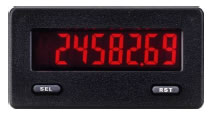Aside from the occasional spin‐off product release, panel meter development has remained relatively static over the last few years. As the market focuses on new products that offer more advanced capabilities, many companies are hesitant to invest money into products – such as panel meters – that fail to drive substantial growth or promise large returns. So where does this leave panel meters? In order to make panel meters a viable option for today’s businesses, compact cost‐effective devices with more advanced features and versatile control options are needed. After exploring market trends, this white paper discusses how to use panel meters to build redundant systems with versatile control options.
Panel Meter Market Trends
Panel meter sales have traditionally come from maintenance, repair and operations (MRO) customers who buy in small quantities for stand‐alone systems. In this case, the devices are typically used to read and display a value for a range of applications that include conveyor speed, water pressure, part counts and material weights. Recently, the market has expanded to include more comprehensive applications. In addition to displaying information, panel meters are also used as a convenient means for local control and as a component in redundant back‐up systems.
Displaying Status Information
Local panel meter displays provide line workers with status information ranging from production target numbers and machine speed rates to tangible production goals. Displaying data not only keeps workers informed, but also helps to drive more efficient speeds that increase overall worker productivity. Simple machine control is another reason why local displays are important. Workers are able to make adjustments in real time to respond to changing conditions. This helps to keep the entire process running as efficiently as possible. Additionally, existing maintenance staff are able to support the equipment so programming engineers are no longer required for PLC support, resulting in time and cost savings.
Building Redundant Systems
For many applications, panel meters can be used in addition to PLCs as part of a redundant system. In assembly line applications, PLCs control speeds to ensure the conveyer does not exceed set maximum speeds. However, if PLC failure occurs, there is no way to control and maintain set speeds and expensive production malfunctions may result. That is why many machine builders often connect a panel meter to the system to help diminish risks associated with PLC failure. Programmed to provide the operator with speed readouts, the panel meter will cut‐off conveyor power should over‐speed occurrences happen. The combination of panel meters and PLCs to control machines helps to ensure continuous operations.
Using Versatile Control Options

Panel meters have become standard for a wide range of applications. As such, many organizations are seeking smaller meters that offer advanced capabilities and versatile control options. To meet this demand, panel meters for applications such as temperature indication and On/Off control are now available in 1/32 or 1/16 DIN‐rail packages. However, while the overall height and width dimensions meet application requirements, the smaller display is not always easy to read—even at a nominal distance. This is why a larger 1/8 DIN package may prove more optimal for control applications.
In order to meet display and control requirements coupled with size and cost restrictions, more versatile panel meters are now available. The CUB®5 series from Red Lion Controls delivers a flexible display and control solution in a package that is 30 percent smaller and 50 percent more affordable than 1/8 DIN panel meters.
CUB5 panel meters feature easy‐to‐read .46" (11.7 mm) LCD displays, available in reflective or backlight options. While the height is comparable to most 1/8 DIN meters, the 2.95" (79 mm) x 1.95" (39 mm) package is less than 1.75" (44 mm) deep. By making efficient use of panel real estate, this package requires less depth for enclosures to offer organizations space and cost savings. Plus, the CUB5 offers many of the 1/8 DIN panel meter features at a lower price. These include selectable inputs, display scaling and a NEMA4X/IP65 sealed front panel.
Featuring a single and dual setpoint output, CUB5 meters allow organizations to cost‐effectively address control applications such as measuring DC current and voltage, processing signals from flow meters, pressure sensors and positioning sensors as well as accepting inputs from RTD and Thermocouple sensors. In addition, plug‐in option cards are field installable to ease deployment. For example, a relay module featuring a Form C relay capable of switching up to 1 amp and a dual NPN‐OC transistor module can be used to add output capabilities. Plus, along with the setpoints, CUB5 meters feature RS-232 or RS-485 communications are available for data send and receipt.
The versatile capabilities, low cost and efficient use of space make the CUB5 panel meter an ideal solution for a wide variety of local display and control system applications. For more information, please visit www.redlion.net/PanelMeters.



